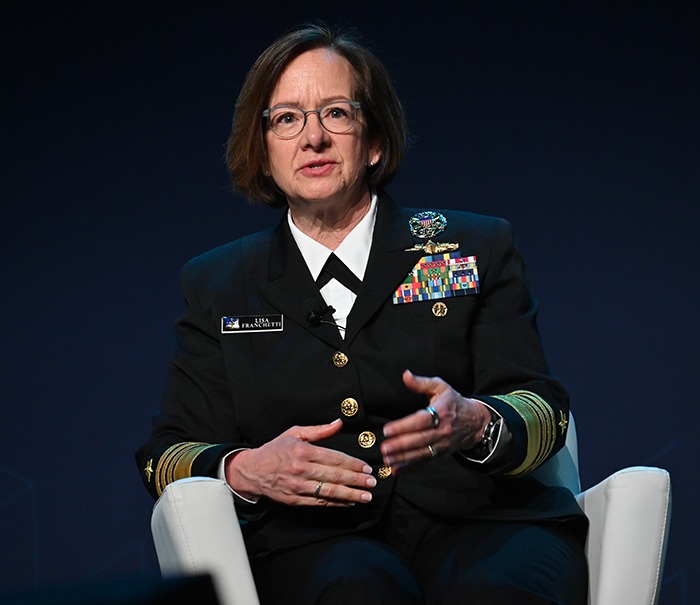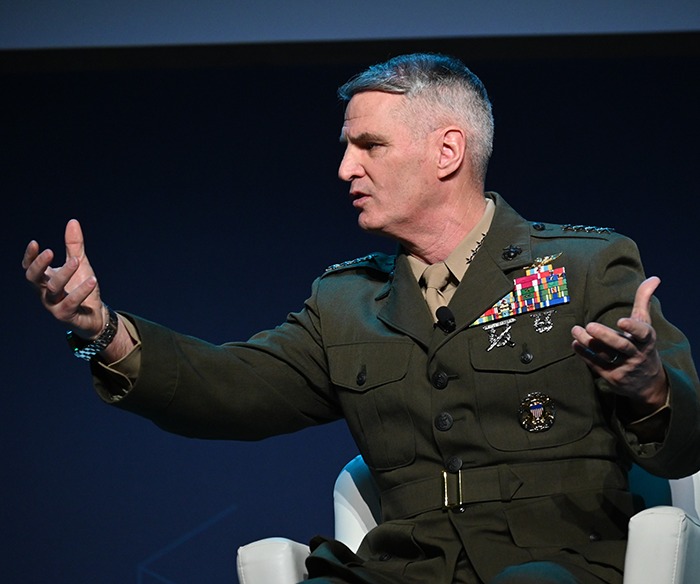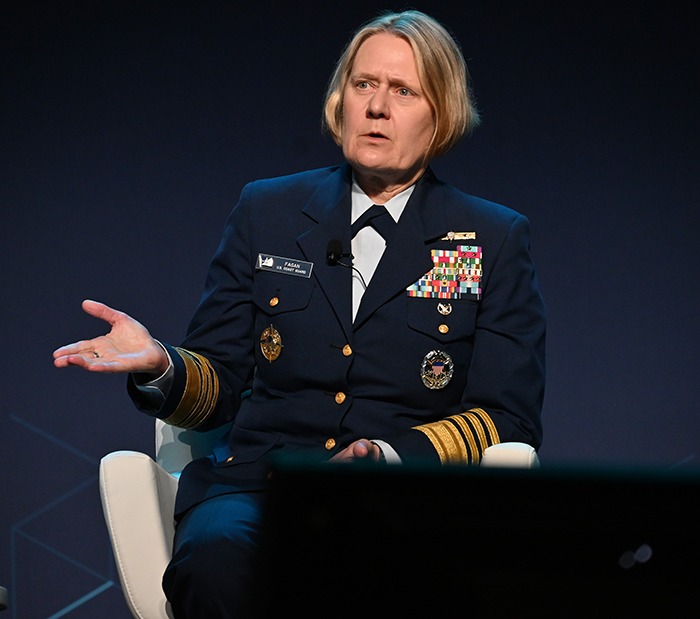
Retention in the Navy and Marine Corps is going well, but recruitment remains a challenge across the services, including the Maritime Administration, and the services must set priorities in a time of great challenges and tight budgets, sea service chiefs said in the kickoff keynote panel of Sea-Air-Space 2024.
Undersecretary of the Navy Erik Raven, who introduced the panel, asked what is needed to continue U.S. dominance. “We need budgets to support our strategy, with people and readiness coming first,” he said.
He noted the fiscal 2025 Navy budget request involves “some tough choices, putting quality of service and readiness at the top of the priority list means other program must either must make do or take risks.”
But the proposed budget “boldly advances our undersea capabilities for both U.S. and AUKUS demands, solidifies our commitment to 31 amphibious ships, and advances the landing ship medium into production,” he said.
The panelists then took up the issue of budgets and the challenges facing the services. Chief of Naval Operations Admiral Lisa Franchetti said the service has only a .7% increase in its budget in the fiscal 2025 request, forcing it to set priorities.
Number one is the Columbia-class submarine program, next is near-term readiness in “our forces and our people,” and next is working with industry partners to make that happen.
“You can see the demand signal: 88 ships under contract, 66 under construction … we know we need a larger Navy, every study since 2016 has shown that,” she said. “I think the most effective way to work on that right now is invest in our industrial base, invest in the workforce, invest alongside our industry partners in the infrastructure necessary to really set the conditions to speed up the production and the throughput of the ships and submarines that we need to put more players on the field.”

General Chris Mahoney, the assistant commandant of the Marine Corps, said the fiscal ’25 budget funds the LPDs, LHAs and LSMs the service needs, so “for what allows us to be ready, the 25 program right now is looking very strong.”
Admiral Linda Fagan, commandant of the Coast Guard, said “demand for the Coast Guard is deafening and it’s worldwide,” from dealing with the aftermath of the collapsed bridge in Baltimore to working with small nations that need the presence of cutters to help defend their interests.
She noted there is great Coast Guard demand for new ships as well.
“We, too, are in the largest acquisition that we’ve had since World War II. We compete for the same industrial base space, both new construction and repair with the Navy. And it’s critical for the nation that we’ve got that kind of reliable access and commitment to the new ship capacity and then repair capacity and maintenance capacity for the ships that are operating.”
The Maritime Administration, too, is building new ships, albeit on a much smaller scale, said MARAD Administrator Ann Phillips. Its new builds, five new training ships, are for the Merchant Marine academies.

“We thank Congress for the funding to be able to build these vessels, but when you have a 100% design, when you have firm fixed-price contracts, when you have by law a very small change order budget, and you have commercial best practices being applied, you are able to move through this vessel construction and vessel procurement,” Phillips said. “We’re on budget. We’re nearly on time.”
Retention and Recruitment
Of course, having ships is one thing, but the services must be able to crew them and maintain them, which are challenges of their own.
“I’m happy to say that retention is very good in the Navy right now in almost all of our fields. And so, to me, that’s a signal that people are really committed to our mission,” Franchetti said.
The service is “very focused” on recruiting, she said. “We can have all the best platforms in the world, but if we don’t have the warfighters that can deploy them, we’re not going to be an effective Navy,” she said. “So, we’re focused hard on recruiting,” including by elevating the head of Navy recruiting to a two-star admiral.
The Navy is also “expanding the pool of folks that can join our Navy team,” including by boosting the age of enlistment to 42. “If anybody out there is not turned 42 yet, there should be some recruiters around who are going to sign you up,” she said. “And if your kid is above 18, you and your kid can be enlisted simultaneously.”
The Coast Guard has had a shortfall as well, Fagan said, but has “kind of recovered” and is looking to recruit more effectively as well, including by boosting its recruiting capacity by nearly 25% and going after young people where they are, including standing up junior ROTC programs and even going on Twitch.
“It’s an online collaborative gaming site, which, surprisingly, there were a lot of 20-year-olds,” she joked. “There’s the target audience.”
Mahoney said retention numbers in the Marine Corps are “very, very good. We’ve made mission, we will make mission this year. You heard here first, our attention numbers are good and getting better, but it’s not a condition of stasis. You don’t declare victory and walk on to the next issue.”
The Marines must look at the factors that make and keep young men and women Marines, “and that equates to their conditions of the barracks, access to healthcare, access to childcare, good childcare, good gyms. And you’ve got to bring in new ideas to continually, not sit there and declare victory once again, but to make sure that you are addressing needs that they have,” Mahoney said.






